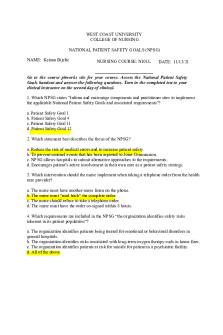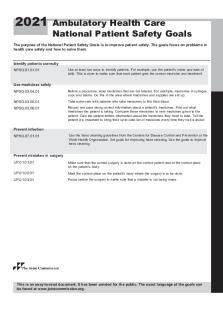NURS101L National Patient Safety Goal Quiz PDF

| Title | NURS101L National Patient Safety Goal Quiz |
|---|---|
| Author | K B |
| Course | Nursing Fundamentals |
| Institution | West Coast University |
| Pages | 4 |
| File Size | 103.3 KB |
| File Type | |
| Total Downloads | 8 |
| Total Views | 125 |
Summary
National Patient Safety Goals Quiz. The Joint Commission....
Description
WEST COAST UNIVERSITY COLLEGE OF NURSING NATIONAL PATIENT SAFETY GOALS (NPSG) NAME: Keiana Bijelic
NURSING COURSE: N101L
DATE: 11/13/21
Go to the course pbworks site for your course. Access the National Patient Safety Goals handout and answer the following questions. Turn in the completed test to your clinical instructor on the second day of clinical. 1. Which NPSG states “Inform and encourage components and practitioner sties to implement the applicable National Patient Safety Goals and associated requirements”? a. Patient Safety Goal 1 b. Patient Safety Goal 4 c. Patient Safety Goal 11 d. Patient Safety Goal 12 2. Which statement best describes the focus of the NPSG? a. Reduce the risk of medical errors and to increase patient safety. b. To prevent sentinel events that has been reported to Joint Commission. c. NPSG allows hospitals to submit alternative approaches to the requirements. d. Encourages patient’s active involvement in their own care as a patient safety strategy. 3. Which intervention should the nurse implement when taking a telephone order from the health care provider? a. The nurse must have another nurse listen on the phone. b. The nurse must “read back” the complete order. c. The nurse should refuse to take a telephone order. d. The nurse must have the order co-signed within 8 hours. 4. Which requirements are included in the NPSG “the organization identifies safety risks inherent in its patient population”? a. The organization identifies patients being treated for emotional or behavioral disorders in general hospitals. b. The organization identifies risks associated with long-term oxygen therapy such as home fires. c. The organization identifies patients at risk for suicide for patient in a psychiatric facility. d. All of the above.
5. Which NPSG addresses “implement fall reduction program and evaluate the effectiveness the program”? a. NPSG 8 b. NPSG 9 c. NPSG 10 d. NPSG 14 6. Which interventions are included in the NPSG “reduce the risk of health care-acquired infections”? a. Implement regular preventive maintenance and testing alarm settings. b. Implement a process to mark the surgical site, and involve the patient in the marking process. c. Use at least two patient identifiers when providing care, treatment, or services. d. Comply with current CDC hand hygiene guidelines. 7. Which order is written correctly according to NPSG #2? a. Administer 4 u regular insulin. b. Administer .25 mg digoxin. c. Administer 10 units NPH insulin. d. Administer stool softener qd. 8. How many NPSG were developed initially? a. 6 b. 9 c. 10 d. 15 9. Which NPSG addresses “implement a standardized approach to “hand off” communication including an opportunity to ask and respond to questions?” a. NPSG #2 b. NPSG #3 c. NPSG #5 d. NPSG #7 10. Which interventions are included in NPSG # 8? a. The complete list of the medications is provided to the patient on discharge from the facility. b. Implement a process of comparing the patient’s current medications with those ordered for the patient. c. A complete list of patient’s medications is communicated to the next provider of service when the patient is referred to another setting. d. All of the above.
11. Which intervention is “develop and implement a protocol to identify new cases of influenza and to manage an outbreak”? a, NPSG #9. b. NPSG #10 c. NPSG #11 d. NPSG #12 12. The nurse administering medication to a patient checks the hospital identification band and ask the the patient’s date of birth. Which NPSG is the nurse implementing correctly? a. NPSG #1 b. NPSG #4 c. NPSG #8 D. NPSG #10 13. Which group must review an alternate approach to the requirement associated with the NPSG? a. The Joint Commission. b. JACHO c. Sentinel Event Advisory Group d. National Patient Goal Safety Group 14, How many National Patient Safety Goals are there as of 2010? a. 6 b. 8 c. 12 d. 15 15. Which interventions are included in NPSG #3? a. Standardize a list of abbreviations, acronyms, symbols, and dose designations that are not to be used throughout the organization. b. Standardize and limit the number of drug concentrations available in the organization. c. Ensure free-flow protection on all generated-se and PCA intravenous infusion pumps used in the organization d. All of the above.
16. The nurse in the surgical unit asks the patient, “Which knee is your doctor going to do surgery?” The patient responds, “my right knee” but the surgical permit states left knee. Which action should the surgical nurse take first? a. Change the surgical permit to read right knee. b. Notify the operating room of the discrepancy. c. Ask the patient’s significant other to clarify. d. Call a “time out” to clarify the situation. 17. Which statement best describes a sentinel event according to the Joint Commission? a. A sentinel event is an unexpected occurrence involving death or serious physical or psychological injury, or the risk thereof. b. A sentinel event is an event that occurs at least ten times in one month and requires medication intervention. c. A sentinel event is a disagreement between the medical staff and the nursing staff which must be resolved in a committee. d. A sentinel event is an ethical dilemma where the patient’s request and the health care team are not congruent. 18. Which NPSG address safety in operating room environment? a. NPSG #9 b. NPSG #11 c. NPSG # 13 d. NPSG # 14 19. Which interventions are included in the NPSG “prevent health-care associated pressure ulcers? a. Assess and periodically reassess each resident’s risk for developing a pressure ulcer. b. Take actions to address any identified risks for developing a pressure ulcer. c. Turn the client every 2 hours while the client is awake. d. A & B 20. Which concentrated electrolyte must be removed from patient care units? a. Calcium gluconate. b. Magnesium sulfate. c. Potassium chloride. d. Zinc oxide....
Similar Free PDFs

PATIENT SAFETY
- 15 Pages

Modul Manajemen Patient Safety
- 60 Pages

Patient Safety - Notes
- 8 Pages

Safety Quiz
- 2 Pages

LAB Safety QUIZ - Quiz
- 3 Pages

Lab Safety Quiz
- 8 Pages

Safety+Quiz 2020 - amazing
- 4 Pages

Lab Safety quiz 2021
- 2 Pages

Laboratory Safety Quiz (online)
- 5 Pages
Popular Institutions
- Tinajero National High School - Annex
- Politeknik Caltex Riau
- Yokohama City University
- SGT University
- University of Al-Qadisiyah
- Divine Word College of Vigan
- Techniek College Rotterdam
- Universidade de Santiago
- Universiti Teknologi MARA Cawangan Johor Kampus Pasir Gudang
- Poltekkes Kemenkes Yogyakarta
- Baguio City National High School
- Colegio san marcos
- preparatoria uno
- Centro de Bachillerato Tecnológico Industrial y de Servicios No. 107
- Dalian Maritime University
- Quang Trung Secondary School
- Colegio Tecnológico en Informática
- Corporación Regional de Educación Superior
- Grupo CEDVA
- Dar Al Uloom University
- Centro de Estudios Preuniversitarios de la Universidad Nacional de Ingeniería
- 上智大学
- Aakash International School, Nuna Majara
- San Felipe Neri Catholic School
- Kang Chiao International School - New Taipei City
- Misamis Occidental National High School
- Institución Educativa Escuela Normal Juan Ladrilleros
- Kolehiyo ng Pantukan
- Batanes State College
- Instituto Continental
- Sekolah Menengah Kejuruan Kesehatan Kaltara (Tarakan)
- Colegio de La Inmaculada Concepcion - Cebu






